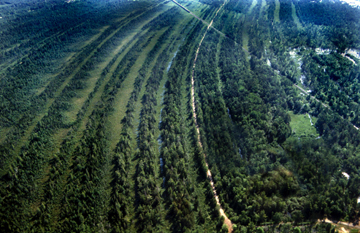
Geotimes Home | AGI Home | Information Services | Geoscience Education | Public Policy | Programs | Publications | Careers

 Ridges of sand
wrap around the offshore edges of Lake Michigan, delineating old shorelines. For
the past decade, Todd Thompson, a geologist with the Indiana Geological Survey,
has used these ridges to reconstruct the lake’s water level over the past
5,000 years. He has found that the lake swings between highs and lows over roughly
30- and 160-year intervals. Those fluctuations have continually varied the habitat
near the lake’s edge — submerging it at times and letting it go dry
at others. This has widened the swath of wetlands rimming the lakes, and maintained
a diverse assembly of plants and animals at Lake Michigan and the other Great
Lakes.
Ridges of sand
wrap around the offshore edges of Lake Michigan, delineating old shorelines. For
the past decade, Todd Thompson, a geologist with the Indiana Geological Survey,
has used these ridges to reconstruct the lake’s water level over the past
5,000 years. He has found that the lake swings between highs and lows over roughly
30- and 160-year intervals. Those fluctuations have continually varied the habitat
near the lake’s edge — submerging it at times and letting it go dry
at others. This has widened the swath of wetlands rimming the lakes, and maintained
a diverse assembly of plants and animals at Lake Michigan and the other Great
Lakes.  |
Geotimes Home | AGI Home | Information Services | Geoscience Education | Public Policy | Programs | Publications | Careers |